ASRock A75 Extreme6 Review and Desktop Llano Overclocking
by Ian Cutress on June 30, 2011 12:05 AM ESTLAN Speed Test
LAN Speed Test is a freeware program designed for testing the network connection between two PCs on a home network. The speed of the transfer is limited by the lowest common denominator on the network, so if you have gigabit Ethernet capable computers but a 100 Mbit capable router, you are limited to 100 Mbit transfer. Note that this is really a formality – if a network port is rated at 1 Gbps, then chances are that it will hit at least 90+% of this value. The main test here is CPU usage, and how much is offloaded by the controller. For this test, we use LAN Speed Test to transfer a 1000 MB file across a home network with a 100 Mbps lowest common speed to the same machine each time, in a read/write scenario. CPU usage is taken as a visual max/average from task manager.

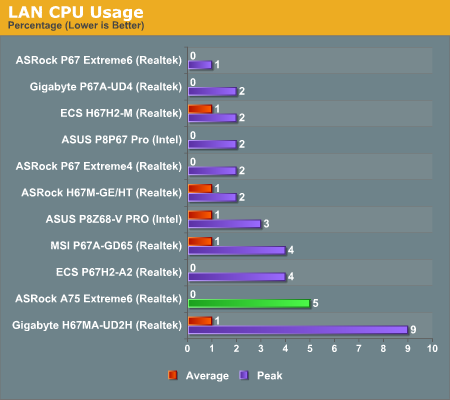
USB Speed
For this benchmark, we run CrystalDiskMark to determine the ideal sequential read and write speeds for the USB port using our 64GB Patriot SuperSpeed USB 3.0 drive. Then we transfer a set size of files from the SSD to the USB drive, and monitor the time taken to transfer. The files transferred are a 1.52 GB set of 2867 files across 320 folders – 95% of these files are small typical website files, and the rest (90% of the size) are the videos used in the Sorenson Squeeze test.
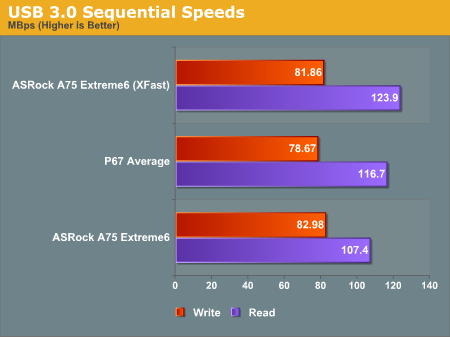
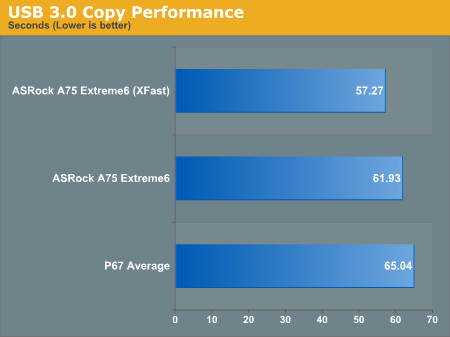
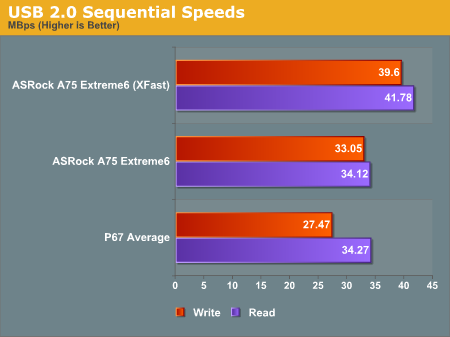
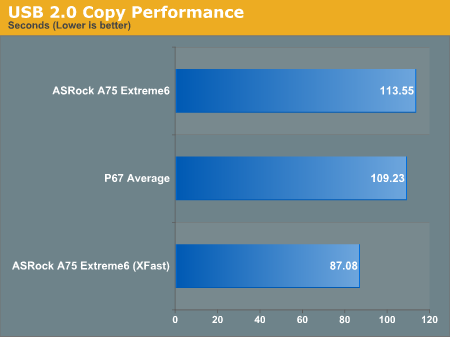
SATA Testing
We also use CrystalDiskMark for SATA port testing. The operating system is installed on the Micron RealSSD C300, which is rated at 355 MB/s read and 215 MB/s write, and the sequential test is run at the 5 x 1000 MB level. This test probes the efficiency of the data delivery system between the chipset and the drive, or in the case of additional SATA ports provided by a third party controller, the efficiency between the controller, the chipset and the drive.
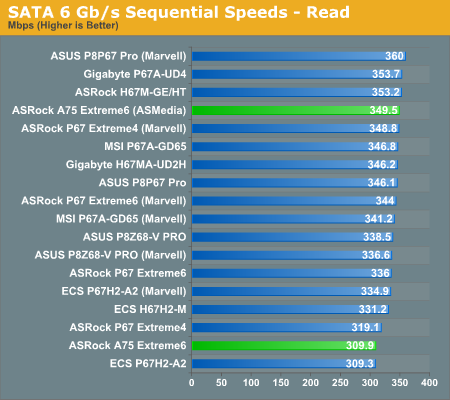

DPC Latency
Deferred Procedure Call latency is a way in which Windows handles interrupt servicing. In order to wait for a processor to acknowledge the request, the system will queue all interrupt requests by priority. Critical interrupts will be handled as soon as possible, whereas lesser priority requests, such as audio, will be further down the line. So if the audio device requires data, it will have to wait until the request is processed before the buffer is filled. If the device drivers of higher priority components in a system are poorly implemented, this can cause delays in request scheduling and process time, resulting in an empty audio buffer – this leads to characteristic audible pauses, pops and clicks. Having a bigger buffer and correctly implemented system drivers obviously helps in this regard. The DPC latency checker measures how much time is processing DPCs from driver invocation – the lower the value will result in better audio transfer at smaller buffer sizes. Results are measured in microseconds and taken as the peak latency while cycling through a series of short HD videos - under 500 ms usually gets the green light, but the lower the better.
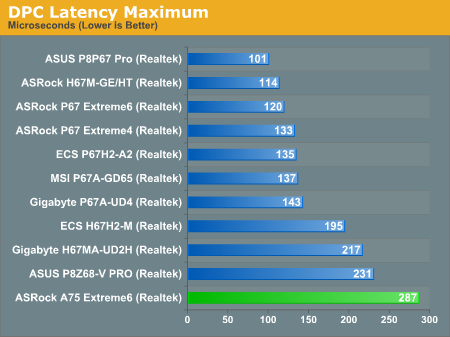










44 Comments
View All Comments
jjj - Thursday, June 30, 2011 - link
no desktop Llano review or there will be one soon?ganeshts - Thursday, June 30, 2011 - link
Coming soon.. We are working on it right now, getting pictures in the engine.FragKrag - Thursday, June 30, 2011 - link
On your conclusion you compared a relatively high end $150 board with budget H67 boards when earlier on in your article you said that the lower end A75 boards would cost around $100.Wouldn't it make more sense to compare a high end A75 board to a higher end H67/Z68 board and a lower end A75 board with the lower end H67? If you did it that way, you would be paying only $25-40 more for Llano over Sandy Bridge.
I do realize you haven't tested one of the $100 A75 boards, but your conclusion seems to be a bit questionable nonetheless.
L. - Thursday, June 30, 2011 - link
Motherboards are going to be much cheaper on the AMD side, as usual.Comparing mobo prices now, and taking a high-end cheap-brand on one side against a cheap board on the other does indeed not make sense.
If it's any indication, my NAS mobo (gigabyte am3) cost like 35 euros. Quite likely that there will be Llano boards around 50 euros before long.
cknobman - Thursday, June 30, 2011 - link
Agreed this article's conclusion is not based off an apples to apples comparison and is really misleading.To the reviewer - please do a better job of trying to compare similar products next time.
qu3ry - Thursday, June 30, 2011 - link
Agreed, and also:"Desktop Llano certainly isn't a low power system - the A8-3850 is rated at 100W, so if you want something to word process, look at emails and play flash games, an AMD Fusion board for $150 will do all that quite easily for all under 60W. "
Alternative: Wait for A8-3800 instead; same IGP but slower clocks (while still faster than say an E-350) @ 65 watts TDP.
Xbitlabs managed to get their hands on A8-3800 silicon which might also be worth reading (no idea what the sites reputation is like so take it with a grain of salt)
http://www.xbitlabs.com/articles/cpu/print/amd-a8-...
ganteng3005 - Thursday, June 30, 2011 - link
What about having a Core i3 2100 + H61 motherboard + Dedicated Radeon HD 6570?It runs faster on both processor and graphics, and the price is equal to the Llano combo.
Other than that --
I love the conclusion part of this article. The cheapest available FM1 A75 motherboard at google shop is currently $103 (if that is true). With the A8-3850, that will end up at $250.
Is Llano a good choice to pick over the i3 2100 for an $25 premium?
Well, it all depends on the user. And the points I would like to make are:
-If you only play flash games, browse the web, type, watch Full HD movies, and use the computer for productivity reasons, pick the Core i3 2100 - the Intel HD graphics will suffice for those flash games - with similar or even better power consumption.
-If you want to do some gaming, then A8-3850 might be the better choice.
Overall, I agree with Anand. I would personally choose the i3 2100 due to its beastial dual-core performance and being able to do anything except heavy GPU stuff - which can be solved by adding a single HD 6570 - and it runs faster than the APU, with the price being similar to the Llano.
TBH, i3 2100 and H61 without any additional GPU will run fine for office desktops. Except if the employees are allowed to play Metro 2033 in office.
AnandThenMan - Thursday, June 30, 2011 - link
What a load of PR rubbish.Exodite - Thursday, June 30, 2011 - link
How so?For mainstream users, which Llano is presumably aimed at, the i3 2100 ends up the better deal as it'll offer better performance in all common tasks.
Llano does have a better native graphics solution, though still not good enough to actually allow for gaming. And if you skip gaming both Llano and the i3 2100 are good enough to handle all other graphics tasks like video and 2D acceleration.
It makes sense to me.
L. - Thursday, June 30, 2011 - link
Stop this please.THERE IS NO SUCH THING AS A COMMON TASK THAT REQUIRES AN i3 2100 !!!
Why do you people keep on throwing that idea around, when it's clear that any basic user (you know, e-mail,facebook,youtube @ home, same @ work + excel, word, stuff) DOES NOT need an i3 (or a Llano for that matter) at all.
Llano has a much much much better graphics solution, which is completely hidden in this biased review as the gpu benchmarks w/ decent RAM are NOT SHOWN (and yes, 2ghz ram is CHEAP today, so anyone buying a Llano should not go for anything lower).
Llano does actually Allow for gaming, the titles tested here only show how with an integrated gpu, you'll be very limited in DEMANDING titles, as Crysis, Metro, ... while NOT demanding titles, like dirt 2 and pretty much everything else, will be fine without _ANY_DEDICATED_GPU_
This will of course not be at maximum settings, but come on, people play on CONSOLES every day, hasn't killed them yet.
I demand a real benchmark, with decent RAMsticks !